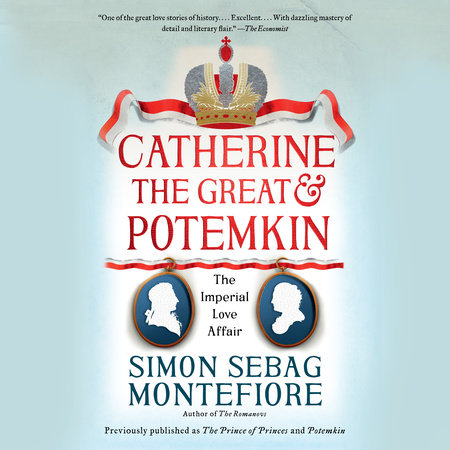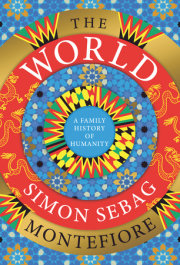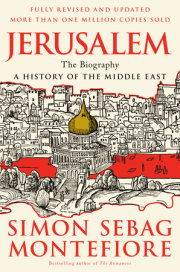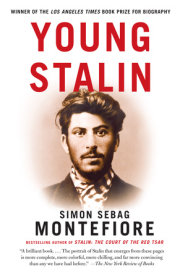Chapter 1
THE PROVINCIAL BOYI would rather hear that you had been killed than that you had brought shame on yourself.
‘When I grow up,’ the young Potemkin is said to have boasted, ‘I shall be either a statesman or an archbishop.’ His schoolfriends probably mocked his dreams, for he was born into the ranks of respectable provincial gentry without the benefits of either name or fortune. His godfather, who understood him better, liked to mutter that the boy would either ‘rise to great honour – or lose his head’. The only way to rise swiftly to such eminence in the Russia of that time was through the favour of the monarch – and by the time he had reached the age of twenty-two this obscure provincial had contrived to meet two reigning empresses.
Grigory Alexandrovich Potemkin was born on 30 September 1739* in the small village of Chizhova, not far from the old fortress city of Holy Smolensk. The Potemkins owned the modest estate and its 430 male serfs. The family were far from rich, but they were hardly poor either. However, they made up for their middling status by behaviour that was strange even by the standards of the wilder borderlands of the Russian Empire. They were a numerous clan of Polish descent and, like all nobility, they had concocted a dubious genealogy. The more minor the nobility, the more grandiose this tended to be, so the Potemkins claimed they were descended from Telesin, the prince of an Italian tribe which threatened Rome in about 100 bc, and from Istok, a Dalmatian prince of the eleventh century ad. After centuries of unexplained obscurity, these royal Italian–Dalmatians reappeared around Smolensk 14 potemkin and catherine bearing the distinctly unLatinate name ‘Potemkin’ or the polonized ‘Potempski’.
The family proved adept at navigating the choppy seas between the tsars of Muscovy and the kings of Poland, receiving estates around Smolensk from both. The family patriarch was Hans-Tarasy (supposedly a version of Telesin) Potemkin, who had two sons, Ivan and Illarion, from whom the two branches of the family were descended. Grigory came from Illarion’s junior line. Both sides boasted middle-ranking officers and courtiers. From the time of Potemkin’s great-grandfather, the family exclusively served Muscovy, which was gradually recovering these traditional Kievan lands from the Commonwealth of Poland–Lithuania.
The Potemkins became pillars of the intermarried cousinhood of Smolensk nobility, which possessed its own unique Polish identity. While Russian nobility was called the dvoryanstvo, the Smolensk nobles still called themselves szlachta, like their brethren in Poland. Smolensk today appears deeply embedded in Russia, but when Potemkin was born it was still on the borderlands. The Russian Empire in 1739 already stretched eastwards from Smolensk across Siberia to the Chinese border, and from the Baltic in the north towards the foothills of the Caucasus in the south – but it had not yet grasped its golden prize, the Black Sea. Smolensk had been conquered by Peter the Great’s father, Tsar Alexei, as recently as 1654 and before then it had been part of Poland. The local nobility remained culturally Polish, so Tsar Alexei con- firmed their privileges, permitted the Smolensk Regiment to elect its officers (though they were not allowed to keep their Polish links) and decreed that the next generation had to marry Russian, not Polish, girls. Potemkin’s father may have worn the baggy pantaloons and long tunic of the Polish nobleman and spoken some Polish at home, though he would have worn the more Germanic uniform of the Russian army officer outside. So Potemkin was brought up in a semi-Polish environment and inherited much closer links to Poland than most Russian nobles. This connection assumed importance later: he acquired Polish naturalization, toyed with Poland’s throne and sometimes seemed to believe he was Polish.
Potemkin’s only famous forebear (though a scion of Ivan’s line) was Peter Ivanovich Potemkin, a talented military commander and later ambassador of Tsar Alexei and his successor, Tsar Fyodor, father and brother of Peter the Great. This earlier Potemkin could best be described as a one-man trans- European diplomatic incident.
In 1667, this local Governor and okolnichy (a senior court rank) was sent as Russia’s first ambassador to Spain and France and then later, in 1680, as special envoy to many European capitals. Ambassador Potemkin went to almost any lengths to ensure that the prestige of his master was protected in a world that still regarded the Muscovite Tsar as a barbarian. The Russians in their turn were xenophobic and disdained the unOrthodox Westerners as not much better than Turks. At a time when all monarchs were highly sensitive the provincial boy 15 about titles and etiquette, the Russians felt they had to be doubly so.
In Madrid, the bearded and heavily robed Ambassador demanded that the Spanish King uncover his head each time the Tsar’s name was mentioned. When the King replaced his hat, Peter Potemkin demanded an explanation. There were rows when the Spaniards queried the Tsar’s titles and then even more when they were listed in the wrong order. On the way back to Paris, he argued again over titles, almost came to blows with customs officials, refused to pay duty on his jewel-encrusted icons or diamond-studded Muscovite robes, grumbled about over-charging and called them ‘dirty infidel’ and ‘cursed dog’. Louis XIV wished to appease this nascent European power and apologized personally for these misunderstandings.
The Ambassador’s second Parisian mission was equally bad-tempered, but he then sailed to London, where he was received by Charles II. This was apparently the sole audience in his diplomatic career that did not end in farce. When he visited Copenhagen and found the Danish King ill in bed, Peter Potemkin called for a couch to be placed alongside and lay down on it so that the Ambassador of the Tsar could negotiate on terms of supine royal equality. On his return, Tsar Fyodor was dead and Potemkin was severely reprimanded for his over-zealous antics by the Regent Sophia.* This curmudgeonly nature seemed to run in both lines of the family.
Grigory Potemkin’s father, Alexander Vasilievich Potemkin, was one of those oafish military eccentrics who must have made life in eighteenth-century provincial garrisons both tedious and colourful. This early Russian prototype of Colonel Blimp was almost insane, permanently indignant and recklessly impulsive. Young Alexander served in Peter the Great’s army throughout the Great Northern War, and fought at the decisive Battle of Poltava in 1709, at which Peter defeated the Swedish invader, Charles XII, and thereby safeguarded his new city St Petersburg and Russia’s access to the Baltic. He then fought at the siege of Riga, helped capture four Swedish frigates, was decorated and later wounded in the left side.
After the war, the veteran had to serve as a military bureaucrat conducting tiresome population censuses in the distant provinces of Kazan and Astrakhan and commanding small garrisons. We do not know many details of his character or career, but we do know that when he demanded to retire because of his aching wounds he was called before a board of the War College and according to custom was stripping off his uniform to show his scars when he spotted that one of the board had served under him as an NCO. He immediately put on his clothes and pointed at this man: ‘What? HE would examine ME? I will NOT tolerate that. Better remain in the service no matter how bad my wounds!’ He then stormed out to serve another two boring years. He 16 potemkin and catherine finally retired as an ailing lieutenant-colonel in 1739, the year his son was born.
Old Alexander Potemkin already had a reputation as a domestic tyrant. His first wife was still alive when the veteran spotted Daria Skouratova, probably on the Bolshoia Skouratova estate that was near Chizhova. Born Daria Vasilievna Kondyreva, she was, at twenty, already the widow of Skouratov, its deceased proprietor. Colonel Potemkin married her at once. Neither of these ageing husbands was an appetizing prospect for a young girl, but Skouratov’s family would have been glad to find her a new home.
The Colonel’s young wife now received a most unfortunate shock. It was only when she was pregnant with her first child, a daughter named Martha Elena, that she discovered that Colonel Potemkin was still married to his first wife, who lived in the village. Presumably the whole village was only too aware of the Colonel’s secret, and Daria must have felt she had been made to look a fool in front of her own serfs. Bigamy then was as contrary to the edicts of Church and state as it is now, but places like Chizhova were so remote, the records so chaotic, and the power of men over women so dominant that stories of bigamous provincial gentry were quite common. At roughly the same time, General Abraham Hannibal, Pushkin’s Abyssinian grandfather, was remarrying bigamously while torturing his first wife in a dungeon until she agreed to enter a monastery, and one of his sons repeated his performance. Torture was usually unnecessary to persuade Russian wives to enter monasteries, thereby releasing the husbands to marry again. Daria visited the first wife and tearfully persuaded her to take holy orders, finally making her own bigamous marriage legitimate.
We can glean enough about this marriage to say that it was profoundly unhappy: Alexander Potemkin kept his wife almost perpetually pregnant. She had five daughters and one son – Grigory was her third child. Yet the splenetic taskmaster was also manically jealous. As jealousy often precipitates the very thing it most fears, the young wife was not short of admirers. We are told by one source that, around the time of Grigory’s birth, Colonel Potemkin was extremely suspicious of his visiting cousin, who was to be Grigory’s godfather, the worldly Grigory Matveevich Kizlovsky, a senior civil servant from Moscow. Presumably the boy was named after Kizlovsky – but was he his natural father? We simply do not know: Potemkin inherited some of his father’s manic, often morose character. He also loved Kizlovsky like a father after the Colonel’s death. One simply has to confront the prosaic fact that, even in the adulterous eighteenth century, children were occasionally the offspring of their official fathers.
We know far more about Potemkin’s mother than about his father because she lived to see Grigory become the first man of the Empire. Daria was goodlooking, capable and intelligent. A much later portrait shows an old lady in a bonnet with a tough, weary but shrewd face, a bold lumpy nose and sharp chin. Her features are cruder than her son’s, though he was supposed to the provincial boy 17 resemble her. When she discovered she was pregnant for the third time in 1739, the augurs were good. Locals in Chizhova still claim that she had a dream that she saw the sun detach itself from the sky to fall right on her belly – and at that point she woke up. The village soothsayer, Agraphina, interpreted this as the prospect of a son. But the Colonel still found a way to ruin her happiness. When her time was near, Daria waited to give birth in the village banya or bathhouse, attended probably by her serf-maids. Her husband, according to the story still told by the locals, sat up all night drinking strong home-made berry wines. The serfs waited up too – they wanted an heir after two daughters. When Grigory was delivered, the church bells rang. The serfs danced and drank until dawn. The place of his birth was fitting, since the banya in the Winter Palace was one day to be the frequent venue for his trysts with Catherine the Great.
Daria’s children were born into a house with a shadow hanging over it – paternal paranoia. Her marriage must have lost whatever meagre romance it ever had when she discovered her husband’s bigamy. His accusations of infidelity must have made it worse: he was so jealous that, when their daughters married, he banned the sons-in-law from kissing Daria’s hand in case the impression of male lips on soft skin led inexorably to sin. After the birth of his heir, the Colonel was visited by, among others coming to congratulate him, his cousin Sergei Potemkin, who informed him that Grigory was not his son. Sergei’s motives in delivering this news were scarcely philanthropic: he wanted his family to inherit the estates. The old soldier flew into a rage, and petitioned to annul the marriage and declare Grigory a bastard. Daria, imagining the monastery gates closing on her, summoned the worldly, sensible godfather Kizlovsky. He hurried from Moscow and persuaded the half-senile husband to drop the divorce petition. So Gregory’s mother and father were stuck with each other.
Grigory Potemkin’s immediate world for his first six or so years was to be his father’s village. Chizhova stood on the River Chivo, a stream that cut a small, steep, muddy gully through the broad flat lands. It was several hours’ journey from Smolensk, whence Moscow was a further 350 versts. St Petersburg was 837 versts away. In summer, it could be baking hot there, but its flatness meant that the winters were cruel, the winds biting. The countryside was beautiful, rich and green. It was and still is a wild, open land and a refreshing and exciting place for a child.
In many ways, this village was a microcosm of Russian society: there were two essential facts of Russian statehood at that time. The first was the Empire’s perpetual, elemental instinct to expand its borders in every possible direction: Chizhova stood on its restless western borderland. The second was the dichotomy of nobility and serfdom. Potemkin’s home village was divided into these two halves, which it is still possible to see, even though the village scarcely exists today. 18 potemkin and catherine
On a slight rise above the stream, Potemkin’s first home was a modest, one-storey wooden manorhouse, with a handsome fac¸ade. It could not have been in greater contrast to the houses of rich magnates higher up the social scale. For example, later in the century, Count Kirill Razumovsky’s estate, further to the south in the Ukraine, ‘resembled more a little town than a country house . . . with 40 or 50 outhouses . . . his guard, a numerous train of retainers, and a large band of musicians’. In Chizhova, the only outhouse around the manor was probably the bathhouse where Grigory was born, which would have stood right above the stream and its well. This banya was an integral part of Russian life. Country folk of both sexes bathed together,* which was very shocking to a visiting French schoolmaster since ‘persons of all ages and both sexes use them together and the habit of seeing everything unveiled from an early age deadens the senses’. For Russians, the banya was a cosy, sociable and relaxing extension of the home.
Copyright © 2005 by Simon Sebag Montefiore. All rights reserved. No part of this excerpt may be reproduced or reprinted without permission in writing from the publisher.












